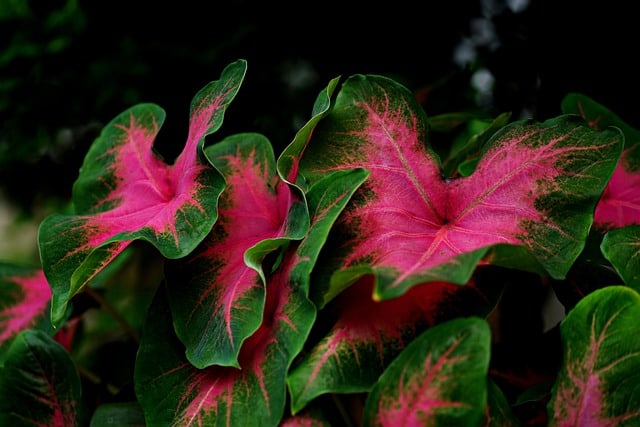Caladiums are a popular houseplant known for their stunning heart-shaped leaves that come in a variety of colors. However, one common problem that many caladium owners face is drooping leaves. This can be a frustrating issue, especially when you’re not sure what’s causing it or how to fix it.
Understanding the causes of caladium plant drooping is essential in resolving the issue. The most common cause of drooping leaves is underwatering or overwatering, but other factors such as overexposure to sunlight, improper soil mix, and overfeeding can also cause the leaves to wilt.
It’s important to identify the cause of the problem to determine the appropriate solution and prevent further damage to the plant.
Key Takeaways
- Caladium plant drooping is a common problem that many owners face.
- The most common cause of drooping leaves is underwatering or overwatering.
- Identifying the cause of the problem is crucial in determining the appropriate solution and preventing further damage to the plant.
Similar posts:
Understanding Caladium Plants
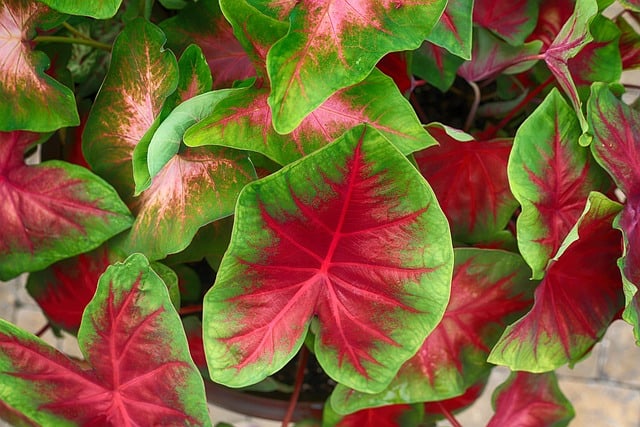
Caladium plants are tropical plants native to South America. They are grown for their attractive foliage, which comes in a range of colors including green, red, white, and pink. The leaves are usually heart-shaped or arrow-shaped, and can grow up to 18 inches in length depending on the variety.
These plants are known for their ability to thrive in warm, humid environments, and are often grown as houseplants or in outdoor gardens in warmer climates. They prefer well-draining soil that is kept consistently moist, but not waterlogged.
Caladium plants are grown for their foliage, not their flowers, and can be propagated by dividing the tubers or planting the seeds. They are relatively easy to care for, but can be prone to a few issues, including drooping leaves.
Drooping leaves are a common problem with caladium plants, and can be caused by a variety of factors. Underwatering is a common cause of drooping leaves, as caladium plants require consistent moisture to thrive. Overwatering can also cause drooping leaves, as it can lead to root rot and other issues.
In addition to watering issues, caladium plants can be prone to pests and diseases, which can also cause drooping leaves. Mealybugs, spider mites, and scale insects are common pests that can infest caladium plants, while fungal diseases like root rot and leaf spot can also cause issues.
Caladium Plant Drooping
Caladium plants are known for their beautiful and colorful foliage, but sometimes they can become droopy and lose their charm. There are several reasons why a caladium plant can droop, and it is important to identify the cause to prevent further damage.
1. Overwatering and Underwatering
Overwatering and underwatering are the most common reasons for caladium plant drooping. When a caladium plant is overwatered, it can lead to waterlogged soil, which can cause root rot and prevent the plant from absorbing nutrients.
On the other hand, underwatering can cause the plant to become dehydrated, leading to drooping and crispy leaves.
2. Temperature Stress
Caladium plants prefer warm and humid conditions, and extreme temperatures can cause stress and drooping. High temperatures can cause the leaves to become yellow and burned, while low temperatures can cause the leaves to become brown and crispy.
3. Overexposure to Sunlight and Low Humidity
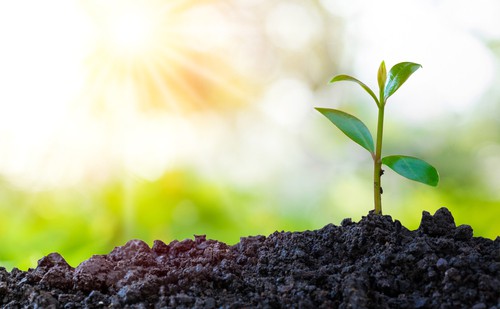
Caladium plants require indirect sunlight and high humidity to thrive. Overexposure to sunlight can cause the leaves to become discolored and burnt, while low humidity can cause the leaves to become crispy and droop.
4. Salt Build-up and Overfeeding
Overfeeding and salt build-up can cause the leaves to become discolored and burnt, leading to drooping. It is important to fertilize caladium plants sparingly and flush the soil regularly to prevent salt build-up.
5. Infestations and Diseases
Infestations such as aphids and diseases such as root rot can cause caladium plants to droop and lose their vitality. It is important to inspect the plant regularly and take action immediately if any pests or diseases are detected.
Impact of Environment on Caladium Health
Caladium plants are sensitive to environmental conditions, and their health can be impacted by various factors such as light, temperature, humidity, and exposure. Understanding how these factors affect the plant’s health is crucial for ensuring their growth and survival.
1. Light
Caladium plants prefer bright indirect sunlight, but direct sunlight can cause the leaves to burn and droop. If the plant is not receiving enough light, the leaves may turn yellow and fall off. It is essential to find the right balance of light for the plant to thrive.
2. Temperature
Caladium plants prefer warm temperatures, but extreme heat or cold can be detrimental to their health. If the plant is exposed to temperatures below 60°F, it may experience seasonal die-back, where the leaves turn yellow and fall off. On the other hand, exposure to temperatures above 85°F can cause the leaves to wilt and droop.
3. Humidity
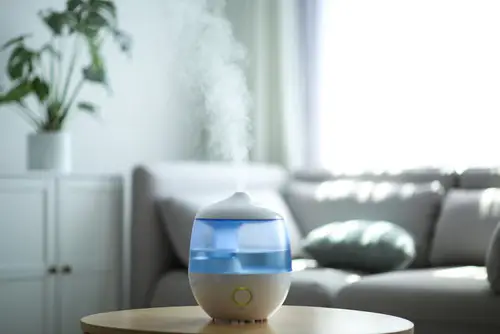
Caladium plants prefer high humidity levels, and low humidity can cause the leaves to dry out and droop. It is recommended to keep the plant in a humid environment, such as a bathroom or near a humidifier, to promote their growth.
4. Exposure
Caladium plants are sensitive to exposure, and sudden changes in exposure can cause the leaves to droop and fall off. It is recommended to acclimate the plant slowly to new environments to prevent shock and promote their growth.
Watering and Soil Requirements for Caladiums
Caladiums require moist soil but not waterlogged soil. Overwatering can lead to root rot and drooping leaves. It is recommended to water the plant when the top inch of soil feels dry to the touch.
When planting caladiums in the garden, it is important to choose a well-draining soil. Garden soil should be rich and well-draining. The ideal soil pH is slightly acidic, at 5.5 to 6.2. If the soil is heavy, it is recommended to amend it with organic matter such as compost or peat moss to improve drainage.
When planting caladiums in containers, it is important to choose a potting soil mix that is well-draining. A damp mix of soil and peat is recommended. The potting soil should be moist but not waterlogged. It is important to ensure that the container has drainage holes to prevent water from accumulating at the bottom of the pot.
Adding perlite, vermiculite, or pumice to the soil mix can also improve drainage. Perlite is a lightweight volcanic rock that helps to aerate the soil and improve drainage. Vermiculite is a mineral that helps to retain moisture and improve drainage. Pumice is a volcanic rock that helps to improve drainage and prevent soil compaction.
Fertilizer Needs and Usage
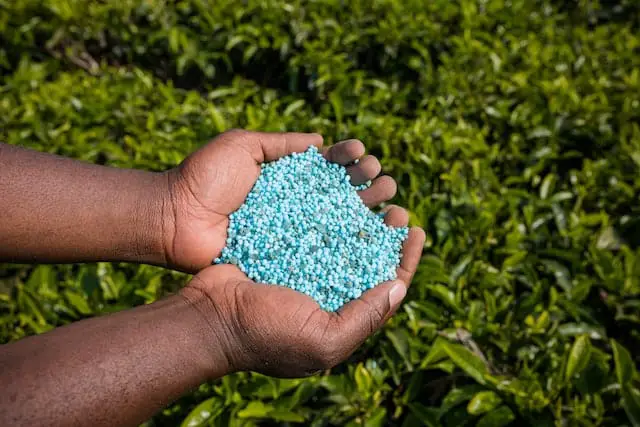
Caladiums require regular fertilization to maintain healthy growth and vibrant foliage. Fertilizers provide essential nutrients that may not be readily available in the soil, ensuring that the plant receives all the necessary elements for optimal growth.
When selecting a fertilizer, it’s essential to choose one that is appropriate for the plant’s needs. Caladiums prefer a balanced fertilizer with equal parts of nitrogen, phosphorus, and potassium.
Avoid using fertilizers that contain high levels of nitrogen, as this can cause the leaves to become too large and reduce the plant’s overall health.
Fertilizer should be applied every two weeks during the growing season, which typically runs from spring to fall. During the dormant period, which is usually in the winter months, fertilizer should be applied sparingly or not at all.
It’s crucial to follow the manufacturer’s instructions when applying fertilizer. Over-fertilization can cause fertilizer salts to build up in the soil, leading to root damage and drooping foliage. Under-fertilization, on the other hand, can result in stunted growth and weak foliage.
To avoid over-fertilization, it’s crucial to water the plant thoroughly before applying fertilizer. This helps to prevent the fertilizer from burning the plant’s roots and ensures that the nutrients are distributed evenly throughout the soil.
Common Caladium Leaf Problems
Caladiums are beautiful foliage plants that are grown for their colorful and showy leaves. However, like any other plant, they can suffer from various problems that can affect their health and growth. In this section, we will discuss some of the common caladium leaf problems that plant owners may encounter.
Caladium Leaves Drooping
One of the most common problems that caladiums face is drooping leaves. The leaves may droop due to underwatering, overwatering, or temperature stress.
Underwatering can cause the leaves to wilt and droop, while overwatering can lead to root rot and cause the leaves to turn yellow or brown. Temperature stress can also cause the leaves to droop, especially if the plant is exposed to cold drafts or hot, direct sunlight.
Brown or Yellow Leaves
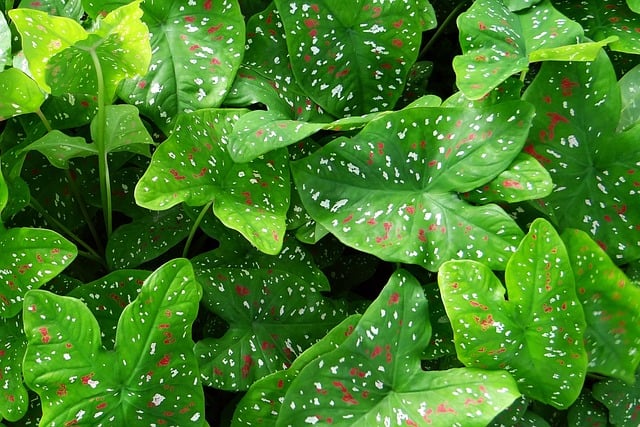
Another common problem that caladiums face is brown or yellow leaves. This can be caused by a lack of energy, which can happen if the plant is not getting enough light to photosynthesize.
If the leaves are turning brown around the edges, it could be a sign of too much direct sunlight. Alternatively, if the leaves are turning yellow, it could be a sign of overwatering or a lack of nutrients in the soil.
Repotting and Pruning Caladiums
Caladiums are tuberous plants that require repotting every two years to ensure they have enough space to grow and thrive. Repotting is also necessary if the potting mix has become too compacted or if the plant has outgrown its current container.
When repotting, it is important to use a well-draining potting mix that is rich in organic matter. A good potting mix for caladiums should contain peat moss, perlite, vermiculite, and compost.
To repot a caladium, gently remove it from its current container and loosen the roots. Trim away any damaged or dead roots with a clean, sharp pair of scissors or pruning shears.
Place the plant in the new container and fill in the gaps with fresh potting mix. Water the plant thoroughly and keep it in a shaded area for a few days to allow it to acclimate to its new environment.
Pruning is another important aspect of caladium care. Pruning helps to remove dead or damaged leaves and encourages new growth. It is best to prune caladiums in the spring before new growth appears.
To prune, simply cut away any dead or damaged leaves with a clean, sharp pair of scissors or pruning shears. It is important to avoid cutting into the healthy parts of the plant as this can lead to infection.
When pruning, it is also a good idea to remove any flowers or flower buds. Caladiums are grown for their foliage, not their flowers, and removing the flowers will help to redirect the plant’s energy towards producing more leaves.
After pruning, it is important to water the plant thoroughly and fertilize it with a balanced fertilizer. This will help to promote healthy growth and prevent the plant from becoming stressed.
In addition to repotting and pruning, it is also important to properly store caladium tubers during the dormant season. Tubers should be dug up in the fall after the leaves have died back and stored in a cool, dry place until the following spring.
When storing tubers, it is important to keep them away from moisture and light to prevent them from rotting or sprouting prematurely.
Caladium Care During Winter
Caladiums are tropical plants that thrive in warm and humid conditions, making them susceptible to damage during the winter months. Proper care during winter is crucial to ensure that the plant remains healthy and vibrant when it resumes growth in the spring.
1. Temperature Fluctuations
Caladiums are sensitive to temperature fluctuations, and exposure to cold temperatures can cause the leaves to droop and wilt. It is essential to keep the plant in an area where the temperature remains between 60 and 85 degrees Fahrenheit.
If the temperature drops below 60 degrees Fahrenheit, the plant can go dormant, and the leaves will start to die back.
2. Ideal Temperature
During winter, it is best to keep the Caladiums in a warm room with plenty of sunlight. If the plant is kept indoors, it is essential to ensure that it receives enough light to maintain its vibrant color. If the plant is kept outside, it is best to cover it with a cloth or plastic sheet to protect it from the cold.
3. Pine Straw Mulch
Mulching the soil around the Caladium plant with pine straw can help to insulate the roots and protect them from the cold. Pine straw is an excellent natural mulch that provides insulation and helps to retain moisture in the soil. It also helps to prevent weed growth and soil erosion.
Caladium as a Houseplant
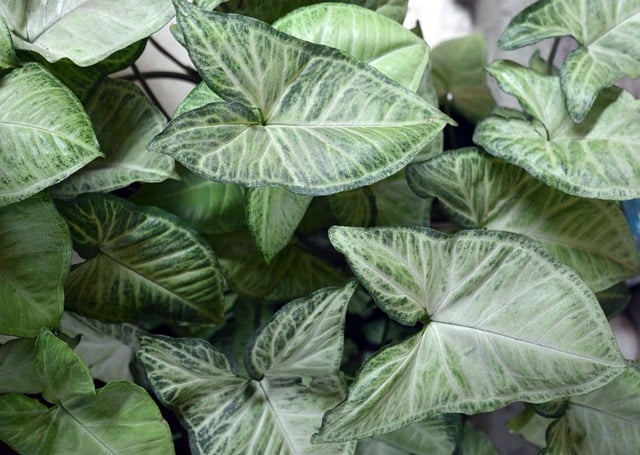
Caladium plants are popular choices for indoor plants due to their beautiful and colorful foliage. They are easy to care for and can thrive in moderate light conditions. Caladiums can add a pop of color to any room and can be grown in pots or hanging baskets.
As houseplants, caladiums prefer moderate light conditions. They can tolerate low light, but their growth may be stunted, and their leaves may lose their vibrancy. On the other hand, too much direct sunlight can scorch their leaves. It is best to place caladiums in a location with bright, indirect light.
Caladiums are also sensitive to water and soil conditions. They prefer to be kept in moist soil, but overwatering can cause root rot and lead to drooping leaves. To avoid overwatering, it is recommended to use a saucer or tray under the pot to catch excess water and allow the plant to absorb it as needed.
In addition to proper watering, caladiums also benefit from occasional fertilization. A balanced fertilizer can be applied once a month during the growing season to promote healthy growth and vibrant foliage.
Frequently Asked Questions
How do you fix sagging caladiums?
If your caladium plant is sagging, the most likely cause is underwatering. To fix this issue, water your caladium plant thoroughly and regularly.
Make sure that the soil is moist but not waterlogged. If your caladium is in a container, ensure that it has proper drainage. If your caladium is in the ground, make sure that the soil is well-draining. If the issue persists, check for other possible causes such as pests or diseases.
How do I know if my caladium is overwatered?
Overwatering is one of the most common causes of caladium drooping. Signs of overwatering include yellowing or wilting leaves, mushy stems, and a foul odor.
To fix an overwatered caladium, reduce watering and ensure that the soil is well-draining. If the issue persists, check for other possible causes such as pests or diseases.
How do you revive a droopy plant?
To revive a droopy caladium plant, first identify the cause of the drooping. If the issue is underwatering, water your plant thoroughly and regularly.
If the issue is overwatering, reduce watering and ensure that the soil is well-draining. If the issue is pests or diseases, treat your plant accordingly. In some cases, pruning may be necessary to remove damaged or diseased foliage.
Why is my indoor caladium dying?
Indoor caladiums can die for a variety of reasons, including underwatering, overwatering, pests, diseases, and environmental stress.
To prevent your indoor caladium from dying, ensure that it has proper drainage, is watered regularly but not excessively, and is kept in a suitable environment with adequate light and humidity.
Do Caladium drooping leaves recover?
Caladium drooping leaves can recover if the underlying issue is addressed promptly. If the issue is underwatering, water your plant thoroughly and regularly.
If the issue is overwatering, reduce watering and ensure that the soil is well-draining. If the issue is pests or diseases, treat your plant accordingly. In some cases, pruning may be necessary to remove damaged or diseased foliage.
Why is my Caladium drooping with brown spots?
Caladium drooping with brown spots may be a sign of fungal or bacterial disease. To address this issue, remove affected foliage and treat your plant with a suitable fungicide or bactericide.
Ensure that your plant is not overwatered and that it is kept in a suitable environment with adequate light and humidity.

Hey, I’m Lisa and I’ve been an avid gardener for over 30 years. I love writing, talking and living in the garden! Feel free to connect with me on my socials below

